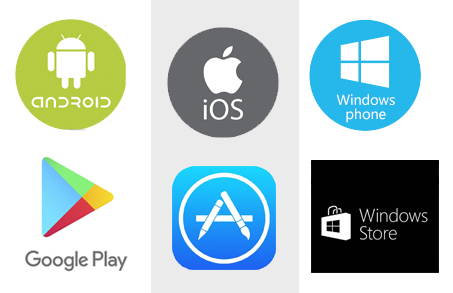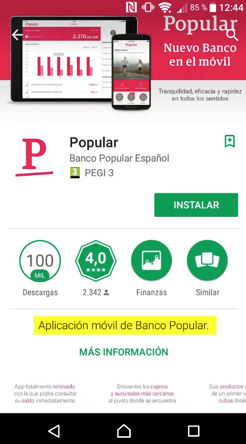Written by Fani Sánchez
Index
- What is ASO?
- Mobile applications
- The business model of mobile applications
- Mobile app stores
- Factors intrinsic to the app to be taken into account in ASO
- Factors extrinsic to the app to be taken into account in ASO
- Factors directly involved in your app’s growth
- Tools for application positioning analysis
- Are you ready to APPly all this?
What is ASO?
ASO is the acronym used for App Store Optimization, i.e. mobile application optimization. It comprises a variety of techniques that, despite not being as extensive or complex as SEO, are useful to know in order to boost the positioning of your application in the different app stores.
Some 21 million individuals between the ages of 16 and 65 have a smartphone in Spain and spend an average of 2:34 hours a day using this device. On average, about 2 apps are downloaded per month and at least 9 of them are used monthly.
Mobile applications
Applications, depending on their purpose, are used by brands in multiple ways. For example, there are native applications that are developed exclusively as a purpose in themselves: the messaging service WhatsApp or the game Candy Crash. Others aim to present the alternative to the traditional web, in a mobile-friendly version: faster and more usable. For example, we have the ASOS or Zara apps for mobile shopping.
The business model of mobile applications
The main business models of apps are:
- Grow enough in volume of downloads and frequency of use to be purchased (for example Whatsapp, which after its purchase is studying other business models such as offering it to large brands as a communication channel with their customers).
- Advertising revenues within the same application.
- Purchases of the application when it has a cost, such as Fintonic, or purchase of extensions or accessories for it (e.g., for most gaming applications).
- Affiliate revenue, such as Just Eat, where they sell third-party services and take a commission for it.
- Or direct sales through the app, as in the Zara or ASOS app, which connects directly to your e-commerce.
Therefore, it is important not only to promote the app outside the mobile universe but also within it, positioning it in mobile app stores through ASO techniques.
Mobile app stores
Mobile app stores are tied to an operating system. Thus, Windows Phone smartphones have the Windows Store, Android devices have the Google Play store and Apple devices have the App Store. During 2015, figures collected spoke of 10 billion annual downloads on the App Store and 16 billion on Google Play. For the Windows Store, no data is available. This represents revenues of between 55 and 100 billion.
In addition to being an almost obligatory step for the acquisition of an app, mobile app stores are a place of discovery. Many users discover apps through specific searches made directly in app stores, according to the Forrester study, which estimates that search-driven downloads comprise 63% of the total.
Although the ones in the image are not the only App stores that exist, they are the most important and that is why in this article we are going to talk about ASO for Play Store and App Store and analyze the ASO factors that we can control.
Factors intrinsic to the app to be taken into account in ASO
These are the factors that we can control through the programming and design of the App itself or from the process of uploading it to the stores. Google Play and the App Store work differently and even have different fields in their tab.
Application name
The name of the application should contain, as far as possible, a keyword describing its main function. This will not always be possible due to branding or other issues, but it is a factor that is taken into account when positioning, so we must take it into account. If we use the application’s own name, we will have to invest a lot more money in advertising and making it known, without taking into account the positioning by related searches, as happens with any new service or brand.
In any case, one practice you should never use is to use the name of a competitor to try to improve your ASO, as it is penalized with expulsion from the app stores.
Keyword Field (App Store)
This field only exists in the App Store. It has a limit of 100 characters to enter the words that best describe the purpose or functionalities of our application. This field is not visible to users but is an administration area for the app store.
For example, for applications such as WhatsApp, keywords could be: messaging service, free messaging, messaging, messages, chat, video calls, calls etc.
Brief Description (Google Play)
Google allows you to include an 80-character field to describe the application. This field can be seen in the first screenshot of the application in the Play Store. It affects ASO at the search and conversion level.
Category
The category is a classification where you must include your application.
- In the Play Store there are separate categories for Games and others for Apps themselves.
- In the App Store these are the existing categories.
Although this is not a ranking factor, the more relevant and accurate the ranking is, the more likely you are to be found by your users.
Icon
The icon is a factor that helps conversion (download). With an attractive, clean and updated design we will have more chances to attract the attention of users as it will give us a professional appearance and transmit our essence.
Screenshots
Screenshots help to explain to the user what he/she will find inside the application: its functionalities and the attractiveness of its design or ease of use. They are also a factor that helps conversion. It should be noted that the first two screenshots are the ones that will be visible at first glance, and 60% of users do not scroll further. Therefore it is important to use at the beginning the most representative screenshots that describe your application.
Promotional video
Play Store allows you to add a promotional video above the description that will play automatically, as an interactive banner. This video is an ASO factor that directly influences user conversion and can persuade them to download.
App Size
The size of the app is a public data that users can see before downloading the app on Google Play. A large size can discourage the user from downloading the app for many reasons: long download time, data tariff cost… Optimize the size of your application to increase conversion.
Factors extrinsic to the app to be taken into account in ASO
These are the factors that do not in themselves make up the construction of the app. That is, they are external factors, unrelated to the programming or design of the app, although they are directly related to them.
Downloads or installations
The more installs a mobile application registers, the more likely it is to rank higher. Google Play shows an estimate of installations, so this factor directly influences the conversion.
Speed of installations
The more installations an application gets, in the shortest possible time, the higher it will climb in the Top Charts. It is not only important to achieve a high number of downloads, but to do so in the shortest possible time.
In this regard , it is very easy to fall into short-term solutions that will not benefit us.Promotional actions well publicized that promise rewards such as advantages, discounts or similar will increase the number of downloads in a short period of time but could also increase the number of uninstallations if we do not define these rewards well or do not promote them in the right channels and end up attracting users who are not within our target audience.
According to the 2016 Annual Mobile Marketing Study, we uninstalled apps due to lack of use (62%), because they were not what was expected (46%) or because they took up too much space (39%). Uninstalls are a factor that also ranks negatively so we recommend keeping an eye on this aspect.
User engagement
One of the most important off-metadata factors is user engagement with an app. If users recurrently access an app, Google will take it into account to highlight it over others. This should be taken into account when designing the app or launching successive versions. For example, by incorporating exclusive or especially useful functionalities for mobile users, we will encourage them to use our App on a recurring basis.
Average score and volume of ratings
The average rating of an app is an off-metadata factor that mainly influences conversion. A user trusts an App with a higher score more. The rating is the result of the average of all the ratings received.
Reviews
Reviews are a difficult ASO factor to control, but they also have a significant weight on your app’s ability to convert. If the average score received does not end up being decisive for a user who is looking to download it (convinced by all other aspects) it is more than likely that he will rely on what others say to make up his mind. Here it will be key to listen to what your audience says, provide support, and be open to incorporate improvements and/or rectifications whenever they are necessary and make sense, in order to maintain a good grade and image.
Mentions in websites
This is an ASO factor related to conversion. References from third parties (bloggers and the media) serve to raise awareness of the app and to provide arguments that convince people to download it. Therefore, promoting our App on sites and applications with similar (finance) or complementary (leisure) themes can improve our positioning indirectly if it leads to an increase in downloads.
Factors directly involved in your app’s growth
In summary, from the elements explained above, we can say that there are two types of factors:
- Factors that help your app’s ASO or positioning in the app store.
- Factors that help to convert, i.e., that encourage the user to download.
This differentiation in turn has distinctions depending on whether we are talking about the Apple (iOS) or Google (Android) app store.
Factors that help ASO
In App Store (iOS)
- App name
- Key words
- Name and history of the developer
- Number of installations
On Google Play (Android)
- App name
- Brief description of the app
- Full description of the App
- Name and history of the developer
- Number of installations
- User ratings and comments
Factors that help conversion
In App Store (iOS)
- App name
- Description of the app
- Name and history of the developer
- Icon
- Screenshots
- Promotional video
- App size / weight
- Number of installations
- Average score and number of ratings
- User ratings and comments
- Mentions in websites
On Google Play (Android)
- App name
- Brief description of the app
- Full description of the App
- Name and history of the developer
- Icon
- Screenshots
- Promotional video
- App size / weight
- Number of installations
- Average score and number of ratings
- User ratings and comments
- Mentions in websites
Tools for application positioning analysis
There are tools that will help you with the ASO of your application at all stages. From the consulting phase to the results analysis phase. Shall we see a few?
Keyword Suggesters
To find the right keywords to optimize your description, name or the keyword field itself based on those searches that users use the most, we can make use of several tools:
- Google Keyword Planner
- KeywordTool.io (has a specific area for keyword research of apps)
Analysis and measurement of results
There are multiple tools that will help you make the right decisions and evaluate the evolution of the positioning of your app against your direct competitors. For the most part, they can work by analyzing App Store and Play Store data. They compare the ASO factors of the applications that are public and in some of them, if we link our accounts of the respective marketplace, we can obtain data that are not public, such as the keyword field (which is unfeasible to analyze the competition). Below is a list of some of them:
- AppTweak. One of the most complete, it analyzes all types of data and stands out for its simplicity when comparing with competitors.
- The Tool. From a Spanish company, we would highlight this complete tool for its qualitative analysis of user ratings.
Are you ready to APPly all this?
ASO, like other online marketing disciplines, is not easy to summarize in a post or guide, but ultimately the best way to learn and gain experience is through practice and trial and error. So I encourage you to apply everything seen in this article in your ASO strategy.



